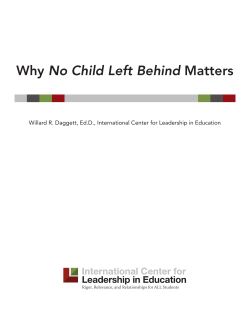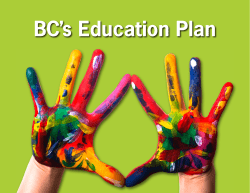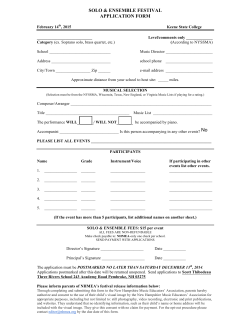
PD Common Language Document
“School systems must create a culture that places value on managing by results, rather than on managing by programs.” (Schlechty, 1997, p.110) Highly effective professional learning communities begin with an invitation and evolve into a culture of expectation for high levels of student learning. Professional learning opportunities move from drive-by, sit and get workshops to daily job-embedded adult learning focused on teaching and learning within the school setting. The work of teams moves from formal meeting structures to powerful conversations that result in relevant solutions for the improvement of professional practices. The culture of the school moves from a hierarchical structure in which decisions are made authoritatively to a shared leadership structure in which trust and respect guide decision making at all levels. Professional development planning moves from a focus on individual learning wants and needs to a team focus on student learning needs and interventions. The following resources are offered to enable you to implement professional learning communities: BOOKS • DuFour, R., DuFour, R., and Eaker, R. (2008). Revisiting professional learning communities at work: New insights for improving schools. Bloomington, IN: Solution Tree • DuFour, R., DuFour, R., Eaker, R., and Many, T. (2006). Learning by doing. Bloomington, IN: Solution Tree • Easton, L. (editor) (2008). Powerful designs (2nd Ed.) Oxford, OH: National Staff Development Council • Hirsh, S. and Killion, J. (2007). The learning educator: a new era for professional learning. Oxford, OH: National Staff Development Council • Hord, S. and Sommers, W. (2008). Leading professional learning communities. Thousand Oaks, CA: Corwin Press WEBSITES • www.ASCD.org • www.nsdc.org • www.solution-tree.org • allthingsplc.com Created by the New Jersey Professional Development Partnership: NEW JERSEY EDUCATION ASSOCIATION 180 W. State Street, P.O.Box 1211, Trenton, NJ 08607-1211 609 599 4561 njea.org A Common Language for Professional Learning Communities The New Jersey Professional Development Standards for Educators provide a foundation for the creation of professional learning communities in New Jersey schools. In addition, new requirements for school level professional development planning that describe ongoing collaborative learning among professionals are core to the implementation of these Standards. In the spirit of enabling all educators to realize maximum results, A Common Language was prepared with three purposes in mind: “Only organizations that have a passion for learning will have an enduring influence.” Covey, Merrill, & Merrill, 1996 •For all participants in a Professional Learning Community, A Common Language for Professional Learning Communities provides a description of the essential terms most commonly used in shaping and discussing a professional learning community (PLC) structure. •The intention of this publication is to invite all educators to share a common language and understanding of the terminology, purpose and processes involved in establishing and sustaining a professional learning community. •ThegoalofenablingalleducatorstoimplementProfessional Learning Communities in their schools/districts at high levels of success creates the context for maximum learning and teaching for students and staff. A Common Language for Professional Learning Communities “A professional learning community requires intention, a focus on learning, a focus on results, a commitment to collegiality and a willingness to reshape a schools culture.” (Crow, 2008) Collaborative teams engage in collective inquiry into their practice. Activities may include: •examining data on student progress; •analyzing student work; •determining effective strategies to facilitate learning; •designing and critiquing powerful lessons; and •developing classroom-based common assessments to measure progress. The Vision The member organizations of the Professional Development Partnership are committed to a collective vision to assist educators in creating effective, high functioning professional learning communities for the purpose of improved student learning. There is a significant body of research that describes the necessity for schools in the 21st century to function as learning organizations united by a shared vision of student and staff learning and common values of respect, caring and shared governance practices. Such school communities are learner-centered and committed to continuous improvement. The hallmark of an effective learning organization is that educators are continually learning together in order to create the results they desire. Educators committed to working together using processes of inquiry, problem solving, and reflection upon their practice become a professional learning community. A professional learning community is a team or group of teams working interdependently to achieve a common goal for which members hold themselves mutually accountable. (Dufour, 2006) T eams are the fundamental building blocks of professional learning communities. An effective, high functioning team regularly engages in collaboration through job-embedded opportunities that build upon and extend the shared knowledge of team members. Collaboration is a systematic process in which all educators work together to analyze and impact their professional practice in order to improve student learning. (DuFour, 2006) Teams working collaboratively in a professional learning community may be: •A whole school •A grade level team •A department team •An interdisciplinary team •A content area team •A thematic team •A team across schools and disciplines •An online network “Teams bring together complementary skills and experience that exceed those of any individual on the team. Teams are more effective in problem solving. Teams provide a social dimension that enhances work. Teams motivate and foster peer pressure and internal accountability. Teams have more fun.” (Katzenbach and Smith, 1999) In a professional learning community, collaboration focuses on the critical questions of learning: •What is essential for students to know? •How will we know when they have learned it? •What interventions will we put in place when they don’t learn it? •What do teachers need to know and be able to do to support the student learning? •What professional learning must the team engage in for student learning? Collaboration is “pooled mental work”. (David Perkins, King Arthur’s Round Table, 2003) Learning teams may also engage in collaborative activities with other educators within and across school and district boundaries and through virtual networks that broaden and enrich their instructional focus. District and school leaders (superintendents and principals) play key roles in fostering, advancing and sustaining schools as learning organizations focused on continuous school improvement. In addition, teachers who take on leadership roles as facilitators, mentors and coaches within professional learning communities and teams enhance the vision of school improvement and share the responsibility for its success. The value of the distributed leadership or teacher leadership model is that it provides “a practice of collective leadership wherein both the formal and informal school leadership blend to follow the contours of expertise in the organization while all educators remained “Well-implemented professional focused on achieving goals that improve teaching learning communities are a powerful means of seamlessly and learning.”(Firestone and McCarthy, 2008). This blending teaching and new paradigm of shared leadership necessitates that professional learning in ways all stakeholders, especially teachers, assume roles outside of the traditional model of how they interface that produce complex, intelligent behavior in all teachers and with each other and work collaboratively as partners school leaders.” toward common goals. (Sparks, 2005) CHANGE Profound changes in a school’s culture will be needed to create learning communities. This will take strong leadership, perseverance, time and an acceptance that change is a process, not an event. Successful school and teacher leaders understand that change can’t be imposed. To unleash the forces of innovation and the passion of individuals for meaningful staff learning, the staff must be fully involved in the change. Change is incremental. Change is the means to help us get better at what we are already doing. It provides the roadmap to creating a culture based on mutual trust and respect. Within this new culture, an enriched climate is created in which the work of improvement is valued, becomes deeper, and remains focused on student learning. High functioning professional learning communities thrive in this climate, allowing for a shift from isolated practices to collaborative decision-making and shared responsibility. Once the habit of mind for working in professional learning communities is established, the learning organization begins to develop the capacity for institutionalizing the essential changes for doing the important work of teaching, learning and leading while building the capacity of its members to continue and strengthen its work. Sustaining this culture demands a constant celebration of successes, a renewal of professional motivation, and an affirmation of making a lasting difference in the lives of the students within the school.
© Copyright 2025





















